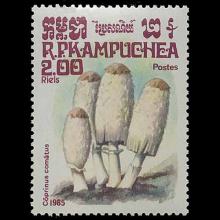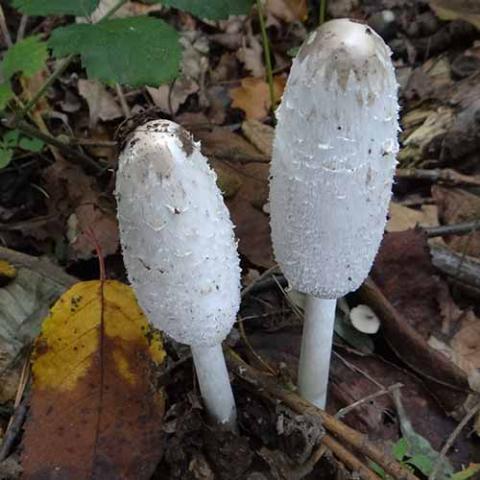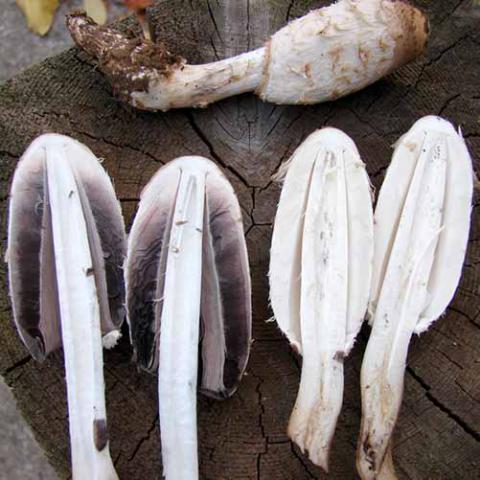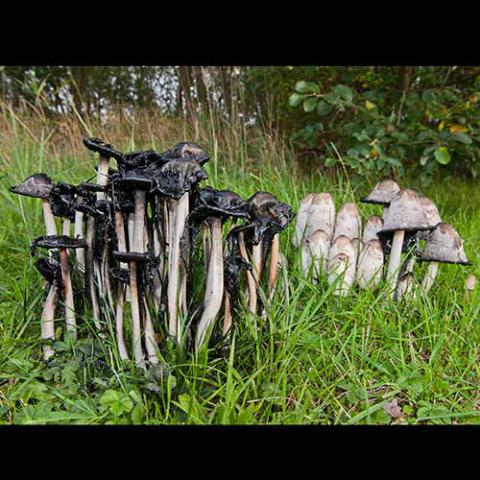NAMES
TAXONOMY
FUNGI ID
THERAPEUTIC
Cambodia
Issued:
Stamp:
Coprinus comatus
Cambodia
Issued:
Stamp:
Coprinus comatus
Cambodia
Issued:
Stamp:
Coprinus comatus
Nature's Ways: Shaggy Mane Mushrooms — a Tasty Autumn Treat
by Centre County Gazette and Mark Nale, October 31, 2019
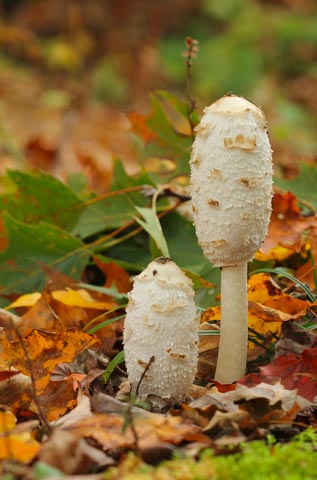
Cooler autumn temperatures bring on colored leaves, archery hunting, spawning trout and scaly, cream-colored shaggy manes.
Right now is the best time to hunt and collect the shaggy mane, a common lawn mushroom. Last fall I had two crops — one in October and a second crop in early November. So far this fall I have only spotted a few. I hope that October showers will stimulate their growth. Although this mushroom usually grows in lawns, I actually found mine growing along the edge of the forest and there have been hundreds of mushrooms at that spot since 2014.
Shaggy manes (Coprinus comatus) are favored by many mushroom hunters because they are delicious and easy to identify. You can even hunt shaggy manes while driving, because they are so easy to spot. This type of “road hunting” is even legal. They grow throughout Pennsylvania and literally around the world.
“Shags,” as mushroom lovers affectionately call them, belong to the family of mushrooms known as the ink mushrooms because, as they age, their cap or top disintegrates to a dark black ink. The “ink” is actually a dark spore-laden liquid, providing the means by which this fungi reproduces.
In George Washington’s time, the dark liquid from the shaggy mane was actually used as an ink for quill pens.
Shaggy manes are large, as mushrooms go, standing up to 9 or 10 inches tall. They are easily identified and often referred to as a “beginner’s mushroom.” Various authors list it as one of the “safe six,” “foolproof four” or whatever title they give the safest wild mushrooms. No other fall North American mushroom looks like the shaggy mane. Shags have an off-white, elongated cap and a white stalk. They get their name because their caps are covered with shaggy-looking scales. Shaggy manes are also called “lawyers’ wigs,” after the white wigs worn by English lawyers. Just a touch of brown often shows at the top of the “wig.”
When these mushrooms first push their way out of the ground, they are smooth and about the size and shape of a large hen’s egg. As they get taller, the bottom of the cap breaks away from the stalk and the cap becomes shaggy. Over the next day or two, at most, the bottom edge of the cap will begin to turn into a black ink, and the mushroom is no longer edible.
Hayfields, recently established lawns, and areas mulched with wood chips are good places to look for this treat. Shags often appear in large groups, but the sprouting of one mushroom has enough strength to move concrete slabs or even break through asphalt. I once collected a bag full from a newly planted and mulched lawn outside of the Altoona Hospital.
If the shaggy mane has one drawback, it would be that they must be frozen or used shortly after picking. The rapid transformation of this mushroom from tasty table fare to black mush is caused by an enzyme and is called autolysis. Careful handling, including picking in a basket or paper bag (never plastic), as well as a quick gentle washing in cold water are essential. A good way to preserve them is to lightly coat a clean, foam egg carton with cooking spray. Place one washed mushroom upside down in each egg compartment. They can also be kept for several hours in ice water.
Cook these mushrooms in large pieces and for only a short time. Their flesh stays white even when cooked and adds a robust flavor to soups, sauces and main dishes. Although shags don’t taste like fish, if they are seasoned with traditional fish seasoning, their texture and color cause diners to swear that they are eating fish.
If some of your mushrooms start to turn to “ink,” Centre County mushroom expert and author Bill Russell recommends that you use those to attempt to establish your own patch. “Scatter (the black ink) around in your lawn and on places where the soil was disturbed or dug up,” Russell wrote. “If you are lucky, you may be picking shaggies in your backyard next fall and probably for years afterward.”
Caution: Never pick and eat wild mushrooms without the help of an expert or at least carefully following a good field guide such as Start Mushrooming, by Stan Tekiela and Karen Shanberg. Russel has written an excellent field guide that goes beyond the beginner stage. His Field Guide to Wild Mushrooms of Pennsylvania and the Mid-Atlantic has full-color photographs and accurate descriptions of many species.
Genus species (Fungi): Coprinus comatus
Coprinus comatus, the shaggy ink cap, lawyer's wig, or shaggy mane, is a common fungus often seen growing on lawns, along gravel roads and waste areas. The young fruit bodies first appear as white cylinders emerging from the ground, then the bell-shaped caps open out. The caps are white, and covered with scales—this is the origin of the common names of the fungus. The gills beneath the cap are white, then pink, then turn black and secrete a black liquid filled with spores (hence the "ink cap" name). This mushroom is unusual because it will turn black and dissolve itself in a matter of hours after being picked or depositing spores.
When young it is an excellent edible mushroom provided that it is eaten soon after being collected (it keeps very badly because of the autodigestion of its gills and cap). If long-term storage is desired, microwaving, sauteing or simmering until limp will allow the mushrooms to be stored in a refrigerator for several days or frozen. Also, placing the mushrooms in a glass of ice water will delay the decomposition for a day or two so that one has time to incorporate them into a meal. Processing or icing must be done whether for eating or storage within four to six hours of harvest to prevent undesirable changes to the mushroom. The species is cultivated in China as food.
The mushroom can sometimes be confused with the magpie fungus which is poisonous. In America, the 'vomiter' mushroom Chlorophyllum molybdites is responsible for most cases of mushroom poisoning due to its similarity with shaggy mane and other edible mushrooms.
Reference: Wikipedia
Photo: Jerzy Opioła, Hannes Grobe, IndianaMushrooms.com

